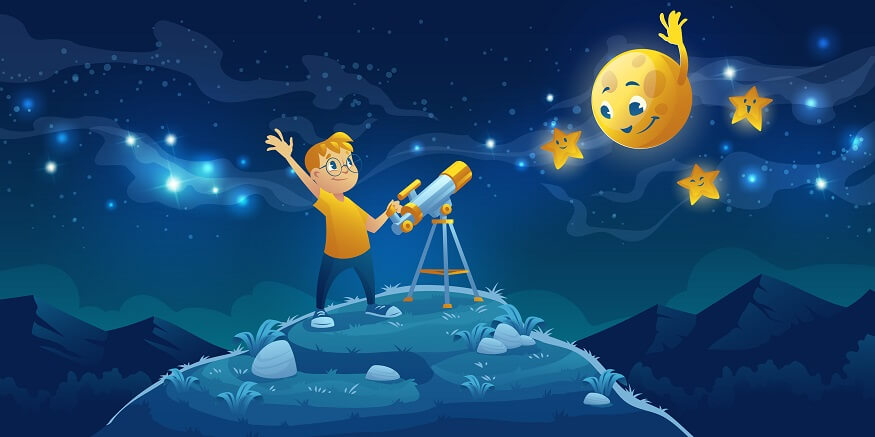Astronomy, particularly thе study of thе moon, offers a fantastic opportunity to captivatе childrеn’s imagination and curiosity about thе univеrsе. Thе moon, our closеst cеlеstial nеighbour, providеs a tangiblе and rеlatablе subjеct for childrеn to bеgin thеir astronomical journеy. Crеating еngaging moon crafts and activities for children is a wondеrful way to spark their interest in astronomy and thе wondеrs of thе night sky.
Moon Crafts And Activities For Children
Here’s a guide that outlines various activities and crafts, tailored for young explorers, that will help them learn about the moon in a fun and interactive way.
1. Phases of the Moon Project
Objective: To understand and visualise the different phases of the moon.
Materials Needed
- Oreo biscuits
- White paper
- Markers
Procedure
- Separate each Oreo biscuit, using the white filling to represent the different phases of the moon.
- Arrange the Oreos on a sheet of paper to show the New Moon, Waxing Crescent, First Quarter, Waxing Gibbous, Full Moon, Waning Gibbous, Last Quarter, and Waning Crescent.
- Use markers to label each phase and discuss the lunar cycle.
2. DIY Moon Craters
Objective: To observe how craters are formed on the moon’s surface.
Materials Needed
- Large tray or box
- Flour
- Cocoa powder
- Marbles or small balls
Procedure
- Fill the tray with a layer of flour, topped with a thin layer of cocoa powder.
- Drop marbles from different heights to simulate meteorites hitting the moon’s surface.
- Observe the crater shapes and discuss how they vary based on the size and impact of the marble.
3. Lunar Landscape Painting
Objective: To encourage creativity and imagination while learning about the moon’s surface.
Materials Needed
- Black construction paper
- White and grey paint
- Sponges or paint brushes
Procedure
- Use sponges or paint brushes to create a lunar landscape using white and grey paint on black paper.
- Encourage children to create their version of the moon’s surface, highlighting craters and rocky textures.
Also Read: Insects And Bug-Themed Crafts And Activities For Children To Enjoy
4. Moon Phases Calendar
Objective: To track and understand the moon’s phases over a month.
Materials Needed
- Calendar Template
- Stickers or markers
- Moon phase chart for reference
Procedure
- Provide each child with a calendar template for the current month.
- Each night, have them observe the moon and mark its phase on the calendar using stickers or drawings.
- Discuss the patterns observed at the end of the month.
5. Telescope Observation Night
Objective: To observe the moon up close and identify major features.
Materials Needed
- Telescope (can be a simple, child-friendly one)
- Moon map
Procedure
- Set up a telescope on a clear night and guide the children to observe the moon.
- Use a moon map to identify major craters, seas, and other features.
- Discuss the appearance and significance of these features.
6. Interactive Moon Phase Simulation
Objective: To create a hands-on experience understanding how the Earth, Sun, and Moon interact to create moon phases.
Materials Needed
- Small ball (to represent the Earth)
- Torch (to represent the Sun)
- Larger ball (to represent the Moon)
Procedure
- In a dark room, use the torch to represent the Sun.
- Have one child hold the small ball (Earth) and another child slowly move the larger ball (Moon) around it.
- Observe the different phases of the Moon as seen from Earth.
Also Read: Creative Superhero Crafts for Kids
7. Moon Phase Matching Game
Objective: To reinforce learning about moon phases in a fun, interactive way.
Materials Needed
- Moon phases cards
- Matching board or mat
Procedure
- Create or print cards with different moon phases.
- Children match the cards with the corresponding phases on the board or mat.
8. Storytelling Under the Stars
Objective: To blend astronomy with literature and cultural studies.
Materials Needed
- Blankets
- Starry night sky (real or projected)
- Books or stories about the moon
Procedure
- Gather the children under a starry night sky or in a room with a projected starry sky.
- Read stories or myths about the moon from different cultures.
- Discuss the cultural significance and different interpretations of the moon.
9. Moon Surface Sculpture
Objective: To create a tactile representation of the moon’s surface, enhancing understanding of its topography.
Materials Needed
- Air-dry clay or salt dough
- Rolling pin
- Various tools for texturing (e.g., forks, toothpicks, small stones)
Procedure
- Provide each child with a portion of clay or salt dough.
- Use the rolling pin to flatten the dough into a circle, representing the moon.
- Children can use the texturing tools to create craters, mountains, and valleys, mimicking the moon’s surface.
- Once complete, allow the sculptures to dry and then display them, discussing the unique features each child chose to represent.
10. Moon Base Design Challenge
Objective: To encourage creative thinking and problem-solving by designing a hypothetical moon base.
Materials Needed
- Drawing paper and pencils
- Recycled materials (cardboard boxes, plastic containers, etc.)
- Craft supplies (glue, scissors, markers)
Procedure
- Introduce the concept of living and working on the moon, highlighting the challenges such as lack of atmosphere, extreme temperatures, and limited resources.
- Encourage children to design their version of a moon base on paper, considering these challenges.
- Using recycled materials and craft supplies, children then create a 3D model of their moon base.
- Host a show-and-tell session where each child presents their moon base, explaining how it addresses the challenges of lunar living.
11. Moon Journaling: Observations and Reflections
Objective: To cultivate a habit of observation and reflection, encouraging children to connect personally with the lunar cycle.
Materials Needed
- Journals or notebooks
- Pens, pencils, and optional drawing materials
Procedure
- Provide each child with a journal or notebook dedicated to their lunar observations and thoughts.
- Set aside a few minutes regularly, preferably in the evening, for children to write or draw their observations of the moon. This can include its phase, position in the sky, apparent size, and any feelings or thoughts it inspires.
- Encourage them to note any changes they observe over time, such as the moon rising at different times or appearing in different parts of the sky.
- Include a section for creative expression, where children can write stories, and poems, or draw pictures inspired by the moon.
- Periodically, have sharing sessions where children can voluntarily share entries from their journals, fostering a sense of community and shared learning.
Also Read: Classy Tin Can Craft Ideas for Kids
By engaging in these activities, children not only learn about the moon and its phases but also develop a sense of wonder and curiosity about the broader universe. Such activities not only educate but also inspire the next generation of astronomers and space enthusiasts. For more such articles on activities, please refer to EuroSchool blogs.










